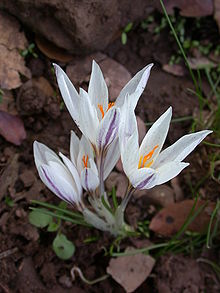- Crocoideae
-
Crocoideae Crocus aleppicus Scientific classification Kingdom: Plantae (unranked): Angiosperms (unranked): Monocots Order: Asparagales Family: Iridaceae Subfamily: Crocoideae
Burnett,Outl. Bot.: 451. Feb 1835.
Genera See text
Synonyms - Ixioideae
Crocoideae is one of the major subfamilies in the Iridaceae family.
It contains plants which are wildly distributed in the Old world, mainly in Africa, but there are species like some members of the genera Romulea and Gladiolus which are native to Europe and Asia. Some examples are Romulea bulbocodium, Romulea columnae, Gladiolus italicus and others.
Like the whole Iridaceae family, the members of the subfamily has the typical sword-shaped leaves. The rootstock is usually a corm. The blooms which sometimes has scent are collected in inflorescence. They contains six tepals. The nectar is produced mostly in the base of the bloom from glands of the ovary. This is the place where the flower forms tube-like end. In some species there is no such end and the plant provides pollen to its pollinator.
The ovary is 3-locular. It contains many seeds with different vision in the different members. Sometimes the seed has fine, delicate coat like in Gladiolus and in other cases It's black and with hard coat like in Babiana. It's often pellet-like, sometimes circular or semi-circular.
Many species of this group are among the best-known ornamental plants in the gardens or in pots. Some good examples are Freesia, Ixia, Crocosmia, Gladiolus and others popular flowers.
Genera
- Afrocrocus
- Babiana
- Chasmanthe
- Crocosmia
- Crocus
- Cyanixia
- Devia
- Dierama
- Duthieastrum
- Freesia
- Geissorhiza
- Gladiolus
- Hesperantha
- Ixia
- Lapeirousia
- Melasphaerula
- Micranthus
- Pillansia
- Romulea
- Sparaxis
- Savannosiphon
- Syringodea
- Thereianthus
- Tritonia
- Tritoniopsis
- Xenoscapa
- Watsonia
- Zygotritonia

This Iridaceae article is a stub. You can help Wikipedia by expanding it.

